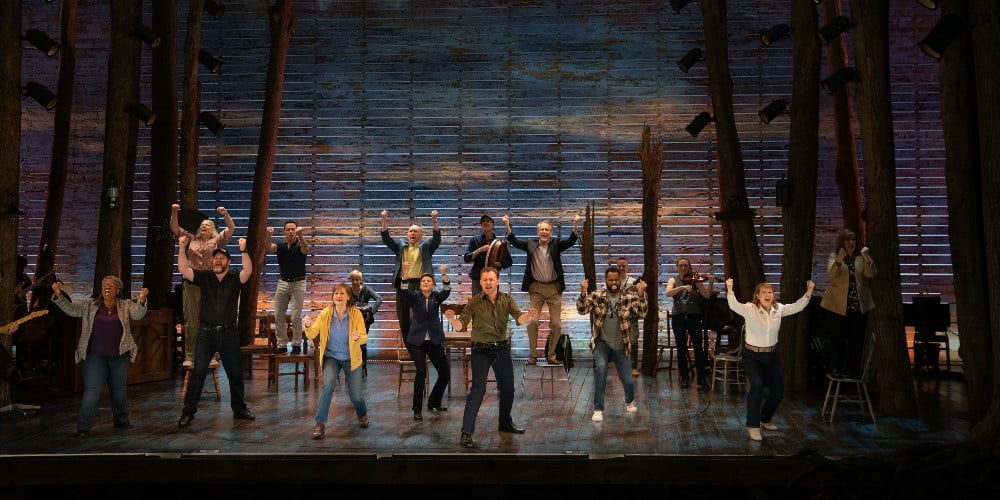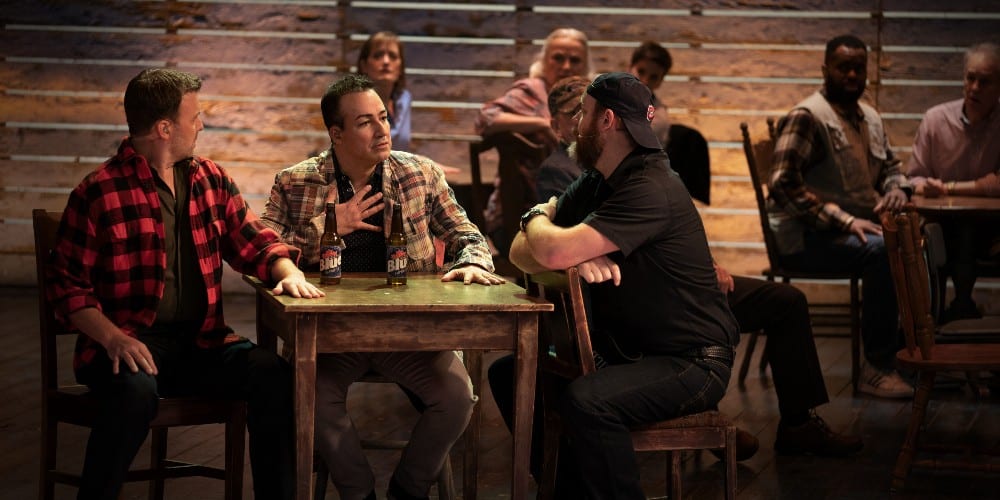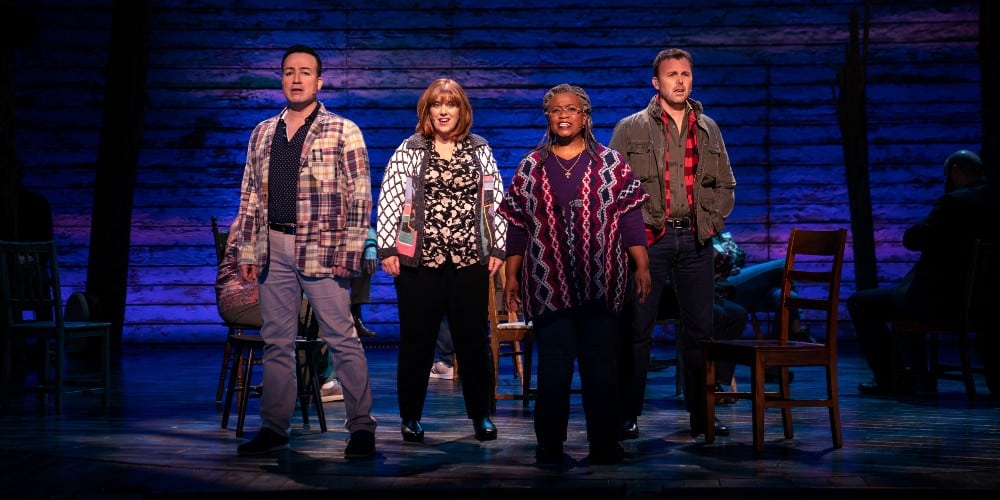The musical true story of a Canadian town that took in 38 planes in the wake of 9/11 is big-hearted and well-staged and deeply frustrating.
“We all come from everywhere, so we all come from away,” Come from Away‘s ensemble crescendos. It’s a rousing thesis statement about acceptance, inclusion, and multiculturalism told with a folksy slant and a slap on the knee. A filmed version from the 2017 Broadway success, the Canadian musical by Irene Sankoff and David Hein tells the true story of 38 planes, their crew, and the passengers, who made an emergency landing in the tiny town of Gander, Newfoundland and Labrador during the 9/11 attacks, and the townsfolk who welcomed them into their homes and hearts.
Throughout its brief runtime, Come from Away showcases an astounding array of characters, each with a poignant, true story to tell. Outside of Jenn Colella’s show-stopping performance of “Me and the Sky” as Beverley Bass, the first female American pilot in history, it’s the show’s ensemble numbers that truly shine.

Maybe it’s because modern movie musicals eschew large choruses, but I found numbers like “Welcome to the Rock,” “Heave Away,” and “10 Years Later” to be tremendously effective in pulling the audience in and making them feel like part of a community. Driving, folk-inspired arrangements, familiar yet their own thing, get everyone stomping their feet before cutting to the heartbeat of the interconnectedness Come from Away aims to make felt.
This is boldly highlighted by the fluidity of the staging. With a cast of just 12 performers, the lives and stories of over 18 “plane people” and Newfoundlanders lattice each other. Performers use subtle costume and accent changes and a slowly turning stage to put new moments forward. Director Christopher Ashley has done a decent job at capturing a complexly staged show for home viewers used to multi-angle storytelling. Some of its best moments come when Ashley sits the camera still and lets us take in all the movement and shifting happening. It feels like high gloss community theater and Come from Away is about community after all.

From the balcony or the mezzanine, this appears to be a heartwarming treatise on pluralism. And in some ways — lyrically, narratively, it still is. But with this up-close view, we see the ways the musical’s staging (re)enacts the underlying problems of multiculturalism.
Because we are not everyone. Our differences are indivisible from us. While the book and lyrics encourage putting those differences together to work for a more community-oriented, holistic good, the staging has performers slipping in and out of beliefs and races. There are no differences in Come from Away, merely costumes. There are the white women who briefly become faceless praying Hindu women and there’s also the major problem of Ali.
Come from Away is a musical that teaches more lessons than it intends, both through its successes and through the moments where it undermines its thesis.
Played by Caesar Samayoa, who also plays the upset gay Kevin, and other characters, Ali is the focus of intense scrutiny in the immediate wake of 9/11. He’s religiously violated during a strip search, his help is declined, and he spends most of the musical in isolation. All because Ali is an Arab Muslim. Yet, Samayoa’s family is from Guatemala and he’s a proud Latino performer, so this does less than nothing for the Arab community who needed immediate help and still feel the social and systemic stigma from 9/11. Here is perhaps the one character whose identity is central, perhaps pivotal, to their role in the story, and he’s played by someone who is not Arab.
This film version arrives while Broadway is still shut down due to the coronavirus pandemic and posits the show and film as a grand moment of (re)coming together. It draws parallels between the desolation of New York after 9/11 and now during the pandemic and the feelings of hope, care, and compassion that were drawn out during those difficult times. Sadly, the hospitality displayed in Newfoundland, New York, and around the globe didn’t take hold like the musical wishes it would. We know there’s a 20-year war just on the other side that will end with only a few gaining anything. We know the Black man’s worries about his safety and systemic racism as he returns to New York are the most justified.

Come From Away wants to inspire us to be a community again, to treat everyone as if they’re home, while also staging identity in ways that disavow the crucial cultural differences between us. It rehearses us in good ways of being “Newfoundlanders,” people who are welcoming and compassionate. Yet, it doesn’t put us through the rite of passage like they do in the show. Where’s the risk? As the show demonstrates, at best multiculturalism celebrates a blending (thus a loss) of identities, at worst it repeats a racist and colonial erasure that whitewashes Arabness and reduces it to a Taqiyah.
Come from Away is a musical that teaches more lessons than it intends, both through its successes and through the moments where it undermines its thesis. For all that works, the show’s warmth and calls for welcoming compassion ultimately cannot quite ring true.
Come from Away is now available on Apple TV Plus.
Come from Away trailer:
Read next: The Spool's Best New Releases
Streaming guides
The Best Live TV Streaming Services With Free Trial
The praises of live TV streaming services don’t need to be further sung. By now, we all know that compared to clunky, commitment-heavy cable, live TV is cheaper and much easier to manage. But just in case you’re still on the fence about jumping over to the other side, or if you’re just unhappy with ... The Best Live TV Streaming Services With Free Trial
How to Watch Power Book III: Raising Kanan Season 3
Season 3 of the hotly anticipated Power spin-off, Power Book III: Raising Kanan, is arriving on Starz soon, so you know what that means: it’s the ’90s again in The Southside, and we’re back with the Thomas family as they navigate the ins and outs of the criminal underworld they’re helping build. Mekai Curtis is ... How to Watch Power Book III: Raising Kanan Season 3
How to Watch Doctor Who: 60th Anniversary Specials
Ladies and gentlemen, we’re so back! To celebrate Doctor Who’s 60th anniversary, the BBC is producing a three-episode special starring none other than the Tenth/Fourteenth Doctor himself, David Tennant. And to the supreme delight of fans (that would be me, dear reader), the Doctor will be joined by old-time companion Donna Noble (Catherine Tate) and ... How to Watch Doctor Who: 60th Anniversary Specials
Which Netflix Country has Interstellar?
Maybe you’ve just seen Oppenheimer and have the strongest urge to marathon—or more fun yet, rank!—all of Christopher Nolan’s films. Or maybe you’re one of the few who haven’t seen Interstellar yet. If you are, then you should change that immediately; the dystopian epic is one of Nolan’s best, and with that incredible twist in ... Which Netflix Country has Interstellar?
Which Netflix Country Has Each Movie of The Hunger Games?
For whatever reason, The Hunger Games series isn’t available in the same countries around the world. You’ll find the first and second (aka the best) installments in Hong Kong, for instance, but not the third and fourth. It’s a frustrating dilemma, especially if you don’t even have a single entry in your region, which is ... Which Netflix Country Has Each Movie of The Hunger Games?
How to Watch ESPN With A Free Trial
One of the major concerns people have before cutting the cord is potentially losing access to live sports. But the great thing about live TV streaming services is that you never lose that access. Minus the contracts and complications of cable, these streaming services connect you to a host of live channels, including ESPN. So ... How to Watch ESPN With A Free Trial
How to Watch Paramount Network With a Free Trial
To date, Paramount Network has only two original shows on air right now: Yellowstone and Bar Rescue. The network seems to have its hands full with on-demand streaming service Paramount+, which is constantly stacked with a fresh supply of new shows. But Yellowstone and Bar Rescue are so sturdy and expansive that the network doesn’t ... How to Watch Paramount Network With a Free Trial
How to Watch WE TV With a Free Trial
Previously “Women’s Entertainment,” We TV has since rebranded to accurately reflect its name and be a more inclusive lifestyle channel. It’s home to addictive reality gems like Bold and Bougie, Bridezillas, Marriage Boot Camp, and The Untold Stories of Hip Hop. And when it’s not airing original titles, it has on syndicated shows like 9-1-1, ... How to Watch WE TV With a Free Trial
How to Watch Comedy Central With a Free Trial
It’s no coincidence that many of today’s biggest comedians found their footing on Comedy Central: the channel is a bastion of emerging comic talents. It served as a playground for people like Nathan Fielder (Fielder For You), Ilana Glazer and Abbi Jacobson (Broad City), Tim Robinson (Detroiters), and Dave Chappelle (Chappelle’s Show) before they shot ... How to Watch Comedy Central With a Free Trial
How to Watch FX With a Free Trial
You’d be hard-pressed to find a bad show airing on FX. The channel has made a name for itself as a bastion of high-brow TV, along with HBO and AMC. It’s produced shows like Atlanta, Fargo, The Americans, Archer, and more recently, Shogun. But because it’s owned by Disney, it still airs several blockbusters in ... How to Watch FX With a Free Trial
How to Watch TNT Sports With A Free Trial
For many sports fans, TNT is a non-negotiable. It broadcasts NBA, MLB, NHL, college basketball, and All Elite Wrestling matches. And, as a bonus, it also has reruns of shows like Supernatural, Charmed, and NCIS, as well as films like The Avengers, Dune, and Justice League. But while TNT used to be a cable staple, ... How to Watch TNT Sports With A Free Trial